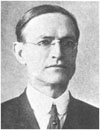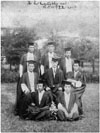Dr. Hirst (1864-1952) (Fig. 1) was a medical missionary who made great contributions to the advancement of medicine in Korea. He served as a missionary for 40 years in Korea, from 1894 to 1934.
Along with Dr. Avison (Ph.D.), Professor Jesse Watson Hirst [Korean Name: Huh Si-Tae (許時泰: 1864-1952)] was a leader at Severance Hospital from its establishment in 1904. He served for about 30 years as the first head professor of the Department of Obstetrics and Gynecology in Severance Hospital Medical School, then as the director of the hospital, and ultimately as a royal physician. As a medical missionary, he greatly contributed to establishing the foundation of Severance Hospital and was passionately dedicated to the advancement of modern medicine in Korea, particularly in the Department of Obstetrics and Gynecology as well as the Department of Nursing.
BIRTH, ACADEMIC ACHIEVEMENT, AND MISSION DEPLOYMENT TO KOREA
Professor Jesse W. Hirst was born into a deeply religious Presbyterian family on December 24, 1864 in Fall River, Massachusetts.
After graduating from Princeton University in 1890, he continued his studies at Jefferson Medical College of Philadelphia in 1893. Later, after completing his residency in Obstetrics and Gynecology at Johns Hopkins University, he acquired a Ph.D. in Medicine and thereafter taught histology, gynecology and diagnostic medicine at Jefferson Medical College for 4 years, until 1904.
As an undergraduate attending Princeton University, he experienced a "call" to become a medical missionary and volunteered for foreign missions as a medical missionary at the Presbyterian North Mission.
At that time, there had been a request for assistance from Dr. Avison, who had been deployed to Korea about 10 years prior and who was affiliated to the same mission to which Dr. Hirst had applied; accordingly, the mission determined that Dr. Hirst was the very man Dr. Avison was looking for, and deployed him to Korea immediately. Dr. Hirst arrived in Seoul on September 19, 1904, ten days before the formal opening of Severance Memorial Hospital.
At the time of his arrival in Korea, Dr. Hirst was a single man at the age of 40 and lived in the home of Dr. Avison. On March 11, 1907, Dr. Hirst married Ms. Sadie Harbaugh (1875-1928), who was a member of the Southern Methodist Churches of America Mission.
Ms. Harbaugh was born in March of 1875 in Rockford, Illinois and grew up in Washington DC. She came to Korea as a missionary affiliated with the Southern Methodist Churches of America.
While serving in the ministry as general secretary of the Songdo Mission, she had initiated the establishment of Songdo School, which was the first school for men in Songdo. Thereafter, she had dedicated herself as an editor of a Methodist missionary magazine, The Korea Methodist, and was a staff member of a United Theological magazine of the Methodist Church and the Presbyterian Church (The Korea Mission Field).
After her marriage to Professor Hirst, she changed her affiliation to the North Presbyterian Churches of America and devoted herself as a teacher at the training school for nurses at Severance Hospital.1
ESTABLISHMENT OF THE FOUNDATIONS OF SEVERANCE HOSPITAL AND THE DEVELOPMENT OF MEDICAL EDUCATION
Professor Hirst had studied basic and clinical medicine to become a medical missionary, and with such comprehensive studies, he was able to perform education and clinical practice concurrently at Severance Hospital. He was mainly in charge of teaching courses such as anatomy, histology, bacteriology, obstetrics and gynecology, and pediatrics (Fig. 2). In the beginning, there were not many doctors; therefore, Dr. Avison had been teaching almost every course.2
The daily schedules of Dr. Avison and Professor Hirst were as follows: in the morning, they led chapel worship and then taught the students and provided medical care for the in-patients and out-patients. In the afternoon, they continued to teach the students and conducted operations and concluded each day by visiting Koreans and foreigners until up to 8-9 o' clock in the evening around the city. Although Professor Hirst taught obstetrics and gynecology classes, his schedule was very tight due to other responsibilities in addition to his own major area.3 When Severance Union Medical College was established in 1913, permitting all of the Christian missions of various churches to participate together, more missionary doctors offered their medical services, allowing Professor Hirst to concentrate only on Obstetrics and Gynecology.4
Owing to the efforts of Dr. Avison and Professor Hirst, the first class of seven men (Pil-Sun Kim, Hee-Yeong Kim, Seo-Yang Park, Chang-Hee Shin, Hyeon-Chik Ju, Seok-Hu Hong, and Jong-Eun Kim) graduated from Severance Hospital Medical School (Che Jung Won) on June 3, 1908 (Fig. 3). They all received the degree of "Doctor of Medicine and Surgery" as well as Certificates of Authorization to Open a Medical Practice, numbered from 1 to 7, from the National Health Service; thus, these graduates received the very first licenses issued to medical doctors in Korea.
DEVELOPMENT OF OBSTETRICS AND GYNECOLOGY AND NURSING EDUCATION
While preparing for medical missions, Professor Hirst had the great expectation that Obstetrics and Gynecology would be a valuable asset on the mission field; however, the social barriers of Korea's Confucian culture regarding gender made it difficult for him to treat female patients. From the establishment of a separate department for female patients in 1886 in Che Jung Won, the female doctors Lillias Horton and Eva Field provided medical care for female patients, although their services did not last due to a number of problems.
It was in this context that Professor Hirst began his first official medical practice in obstetrics and gynecology when Severance Memorial Hospital was opened in 1904, and he was able to train the fourth graduate of Severance Hospital Medical College, Pil-Ho Shin, as his successor. Pil-Ho Shin succeeded Hirst to become the first professor of obstetrics and gynecology in South Korea.4
Daehan Maeil Sinbo (Korea Daily News) published on October 12, 1907 a detailed description of the efforts of medical personnel at the time to raise national consciousness and awareness:
"Mrs. Kim gave birth by easy delivery; while the wife of Mr. Ha-Yeom Kim, who was living in Hap-dong, suffered in labor for many days. He called on Dr. Hirst and medical student Seo-Yang Park at Chejungwon outside the South Gate for help, and within 3 hours after medical examination, they were able to help Mrs. Kim deliver her child safely and treated her very well even after the delivery, enabling the mother to completely recover in a short time. With this news, it is important to note that the excellent medical care resulted in new life in contrast to pointless procedures such as gut or chiseong at the birth of a child according to the customs of Korea."
Dr. Hirst continued his role as head professor for 30 years from 1904 to 1934, including his position as director of Severance Hospital from 1925 to 1927, and strived to cultivate the next generation of doctors. He retired on March 30, 1934, the first professor to do so at the retirement age designated by Severance Hospital, where he was venerated as an honorary professor. The doctor returned to his homeland and resided in Durham, North Carolina until death claimed him at the age of 88 in Florida on April 25, 1952.
Professor Hirst, together with his wife, Madam Harbaugh, also invested a great deal of attention and effort in nursing education, as working together with a female nurse was essential in order to care for female patients and deliver children. In September of 1906, an nursing school was established at Severance Hospital, and the full-scale training of nurses was initiated. Madam Harbaugh also worked in the nursing school actively from March of 1907 as a teacher, and Professor Hirst was invited to participate in the training of nursing students to help E. L. Shields, the first director of the nursing school (Fig. 4).5
SERVICE TO SOCIETY AND THE NATION
Dr. Hirst was also appointed as a physician to the king and as an army doctor who cared for the health of the king and the royal family. At the time, Dr. Avison and Dr. Hirst were appointed as the respective main and the second physicians to the emperor. Although a gama (sedan chair) was the form of main transportation at that time, Emperor Go Jong provided them with a three-man rickshaw. According to a record of that time, A History of Christian Medical Work in Korea, the author Man-Yeol Lee noted that "Emperor Go Jong ordered a new rickshaw for Dr. Hirst and gave it to him with his own driver. Avison and Hirst had a very busy daily schedule sometimes up to 8 or 9 o' clock at night in order to make visits and treat patients around the city in addition to their own work of teaching and examining patients at Severance Hospital. Thus, having their own rickshaws was very helpful."6
Severance Medical College was a central location of the March 1st movement in 1919. Students of Severance Medical College, including Yong Seol Lee, Moon Jin Kim, and Dong Seok Bae, were actively involved in the March 1st movement, and pharmacy staff member Gap Seong Lee was one of 33 representatives for the nation. Severance Medical College students helped to write the Declaration of Independence, and one day, Japanese police raided the College after finding that controversial articles were being kept at Severance Medical College. Professor Hirst stopped the police when they tried to storm into the school and hospital, saying "This place is merely a hospital to train the students and to provide care for patients, and there is no such place to print such manuscripts."7
With the hard-line stance of Professor Hirst, the police could not proceed with the search. The students hided the mimeograph duplicator and the printed materials nearby the corpses in the anatomy lab, and thanks to Professor Hirst, they were later able to distribute the Declaration of Independence throughout the country.




 PDF
PDF ePub
ePub Citation
Citation Print
Print






 XML Download
XML Download